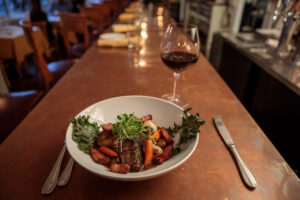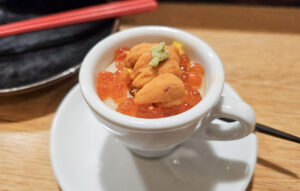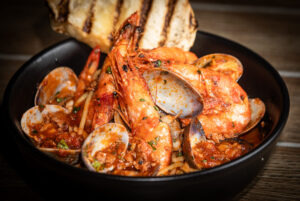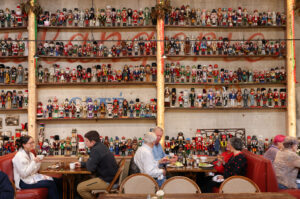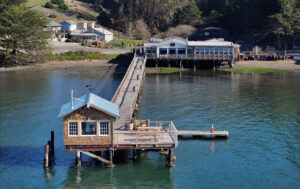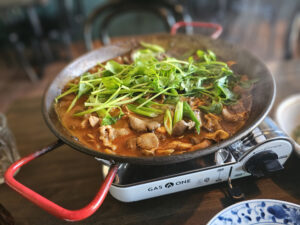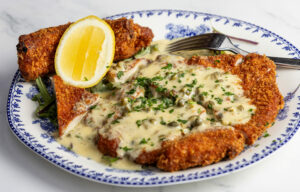
Though the accepted fact that 90 percent of restaurants fail within the first year may be overstated, only about 30 percent of restaurants last for ten years or more, according to research. Here in Sonoma County, especially after the devastation of the recession, there do seem to be fewer and fewer toques still standing.
But what about the restaurants that keep chugging on, year after year, decade after decade? They quietly simmer away becoming our go-tos for weeknight dinners, birthdays and anniversaries, regardless of our momentary dalliances with flashy new eateries. Ingrained in our hearts and communities, they’re comfortable constants. Pity the chef who takes a favorite dish off the menu or tries to reinvent himself.
Ever-present, here are ten restaurants that have stood strong for a decade (or more), weathering ups and downs, reminding us year after year that they’re still around for a reason — and what it’s taken to keep themselves on top.
Jimtown Store, opened 1991
Carrie Brown had to drink a whole lot of inventory before Jimtown found its niche. “We had all these great ideas about what we wanted to do, but we knew from the get go that the customers would figure it out for us,” said Brown, who opened the Alexander Valley outpost with her late husband, John Werner on a warm Memorial Day more than 20 years ago. That meant trying to sell wine from France and fancy cheese — something locals didn’t immediately embrace. “We wound up drinking all the wine. All that beautiful cheese languished,” she said. Transforming from a deli into a cafe and grocery, and ultimately a Wine Country icon, Brown’s most loyal following has always been from the locals who watched as the New York couple renovated the dilapidated grounds and eagerly adopting the store as their “clubhouse”. “They’ve just been overwhelming in the support and love,” said Brown. “They really saved me,” she said of the difficult time after her husband died. Living on the grounds, however, sometimes makes for close quarters and exotic trips make for fresh inspiration. “I like to travel and see the wider world, then bring what I’ve learned back to Jimtown,” she said. 6706 California 128, Healdsburg.

Zin Bistro, opened 1999
Chef-owner Jeff Mall was doing farm-to-table long before it had the kind of foodie buzz it gets today. Now a favorite spot for new American comfort food — from grits and fried chicken to Mexican beer-batted green beans — Mall knew early on that a kitchen garden was key to great dining. “I wanted to grow my own food,” said Mall, who owns Eastside Farm, a source for much of the restaurant’s produce. But fans may also find it interesting to know that it was wasabi that first flavored his vision. A former chef at SF’s Asian-fusion powerhouse, Hawthorne Lane, Mall said he used to sprinkle the Japanese horseradish on nearly everything. “We haven’t done that at Zin for ten years,” he laughs. What he learned the hard way? “At 29 you really don’t know anything about running a restaurant,” Mall said, of the tender age he opened Zin. “I would tell myself to listen –listen to what your customers like and don’t like. Just because you like something, doesn’t mean the public will.” What he’d tell aspiring restaurateurs: “Don’t be intimidated by projects that seem too big or daunting.” Moving from buying bread from bakeries to doing all their bread in-house was a major hurdle he overcame several years ago, but how he says, “It is better than any we had ever bought in the past.” 344 Center Street, Healdsburg.
 Zazu, opened 2001
Zazu, opened 2001
Chef-owners John Stewart and Duskie Estes accidentally hit on three of the biggest trends in food over the last five years: raising their own food, curing meats and making bacon. As trend-setters, they’ve been courted for adverts for California tourism, on the Food Network (multiple times), national morning shows and reigned as The King and Queen of Pork after winning Cochon 555’s pork olympics in 2011. “We got lucky moving to Sonoma County. We had chickens in the backyard, a gateway into urban farming that led to sheep, turkeys and pigs and growing as much as we could to get a better product,” said Stewart. Inspired by those tastes, the couple were inspired to work with local ranchers, using the whole animal and ultimately making their own salumi. Salumi (and a stint with Mario Batali) led Stewart to found Black Pig Bacon — artisanal bacon that ships throughout the West at a rate of 5,000 pounds per month. But it isn’t all luck that keeps their restaurants popular. Instrumental in redefining modern Sonoma County cuisine, they’re respected by the food community for their farm-to-table walk and talk. Plus, there’s never a dull menu at their constantly evolving restaurant. 3535 Guerneville Road, Santa Rosa.
 The Girl and the Fig, opened 1997
The Girl and the Fig, opened 1997
“Be careful what you wish for,” is the advice of chef-owner Sondra Bernstein, whose small cafe has turned into a mini-empire of three restaurants, a catering operation, two cookbooks and a line of fig condiments. The original cafe in Glen Ellen moved to Sonoma in 2000, but continues to show up on “best of” lists as a top spot for typified Wine Country casual cuisine and Rhone-only wine list. Her newest restaurant, Estate, let’ Bernstein and exec chef John Toulze explore their Italian side with house cured meats, pasta and local produce. Their next adventure: A Kickstarter.com-funded mixed-used space called Suite D that will offer classes, tastings, coking classes and private dinners. 10 West Spain Street, Sonoma.
La Gare, opened 1979
Roger Praplan relishes the fact that he’s serving the grandchildren of some of La Gare’s early customers. Praplan’s parents were early entrepreneurs in Santa Rosa’s Railroad Square, purchasing their lot for $25,000 in 1977. Though dining trends have come and gone during the restaurant’s 30-plus years, Praplan stays laser-focused on the traditional French cuisine that’s made the restaurant a popular birthday, anniversary and holiday restaurant for decades. “People always want to reinvent. Just readjust, and stick to your vision,” said Praplan. 208 Wilson St., Santa Rosa.
(Petite) Syrah, opened 1999
Last year chef-owner Josh Silvers took a leap of faith, reinventing his longtime restaurant into a small plates eatery. Though critically successful, the public didn’t embrace it. “People were having a hard time understanding the concept of what we were trying to do,” said Silvers. An adept adapter, Silvers is now bringing back his entrees and tasting menus. “Our job is to make people happy. We’re selling an experience,” he said. For years, that experience was as a spot for rare duck breast, foie gras and Dungeness crab cakes, classic Wine Country fare he felt he just couldn’t take off the menu. The new menu brings together favorites from the new and old menus — duck breast to a 63-degree egg salad. Meanwhile, his wood-fired oven and bar restaurant, Jackson’s, lets Silvers and his staff continue to innovate with more casual cuisine. 205 5th Street, Santa Rosa.
Willi’s Wine Bar, opened 2002
“I was a late bloomer,” said Mark Stark, chef-owner of Willi’s Wine Bar. Working in kitchens large and small for nearly 17 years, including as catering chef for Lulu’s, the potential pitfalls weren’t lost on him. “That’s the scary part. I knew what I was getting into,” said the now-owner of four restaurants (with a fifth in development). His own evolution has been from complicated ingredients to letting the food shine. “Simplicity comes to mind a lot. My style in the beginning was to throw more ingredients at things. But now, the excitement is how simple I can make a plate and make people really enjoy it,” he said. Bravas, opening this summer, exemplifies the move toward simple Spanish flavors. What he’d do if he were starting out today: “Work in a big kitchen and learn the business systems. If you can take the work out of that part, you can focus on food and the part you love to do.” That, and ignore mean Web chatter about themselves. “Bloggers can cut so deep. People have no idea how hard it is to do what we do.” 4404 Old Redwood Highway, Santa Rosa.
Restaurant at Madrona Manor, opened 1981
As Healdsburg has grown up, so has once-unassuming restaurant inside this Victorian bed and breakfast. In 1999, when Bill and Trudi Konrad purchased the property, they hired Chef Jesse Mallgren. An alum of Gary Danko’s at Chateau Souverain and SF’s legendary Stars, Mallgren grew up in Sonoma County. Though he defines his cuisine as first and foremost local and seasonally-inspired, about 10 years ago Mallgren began pushing boundaries with molecular gastronomy techniques that include using liquid nitrogen to make ice cream. “We use the best techniques with the best products,” he said. What he credits with the restaurant’s continued success: Creative control in the kitchen. Free of financial and time constraints of many other chefs, Mallgren can channel his energy into a showcase tasting menu. 1001 Westside Road, Healdsburg.
John Ash & Co, opened 1980
It’s impossible to talk about Sonoma’s longstanding food scene without paying homage to its patriarch, John Ash. What began as an idea became a revolution — using nearby produce, meats and cheeses to create wholesome, ethical, lush food and pairing it with great local wines. Though it seems almost quaint now, Ash was an early pioneer at his Montgomery Village restaurant. Though Ash is no longer in the kitchen of his eponymous restaurant, some of the top chefs and winemakers (Jeffrey Madura, Dan Kosta, Michael Browne) are alums of the historic eatery. Now headed by Chef Tom Schmidt, the restaurant still holds close its original vision. 4330 Barnes Road, Santa Rosa.
 Hana Japanese, opened 1990
Hana Japanese, opened 1990
Tokyo native Ken Tominaga brings a knowledge of authentic Japanese cuisine to Sonoma County. At his Rohnert Park restaurant, you’ll find fish flown in from Japan, along with native seafood and hard-to-find delicacies. A strict aesthetic precision infuses every dish — from tempura and steamed egg custards to steaming dashi and lush nigiri. Having grown up between Santa Rosa and Tokyo, Tominaga brings aspects of both cultures to his food, making it a favorite of local chefs, visiting Japanese and local foodies. 101 Golf Course Drive, Rohnert Park.
K & L Bistro, opened 2001
Chef-owners Karen and Lucas Martin were among the first Bay Area restaurateurs to receive a Michelin star when the guidebooks made their debut in 2006, then big news for the tiny Sebastopol bistro. Through economic ups an downs, the menu has remained focused on classic French favorites including onion soup gratinee, duck leg confit, sole meuniere and their much-loved French fries. 119 South Main Street, Sebastopol
Underwood/Willow Wood, opened 1995, 2002
Everyone thought Matthew Greenbaum was crazy to open the cozy Willow Wood cafe in sleepy Graton — a town better known for the restaurants that closed there than opened. But the rustic eatery charmed its way into national magazines and critical acclaim serving up hearty country fare (polenta, roast chicken and breakfast scrambles, fresh-baked bread) with big city panache. In 2002, Greenbaum and his partner opened the boho-Parisian cafe, Underwood directly across the street seven years later. The tapas-style menu, paired wines from his Green Valley neighbors, continues to make Graton a food-destination for locals and tourists. 9113 Graton Rd., 9020 Graton Rd., Graton.
Farmhouse Inn, re-opened 2001
Siblings Joe and Catherine Bartolomei began revamping this historic Forestville property more than 10 years ago, and are still at it. Longtime chef Steve Litke made Rabbit, Rabbit, Rabbit his trademark, but in March 2011 turned the menu on its ear by offering a luxe prix fixe (ie: langoustines with yuzu, miso glazed bone marrow) with wine pairings from master sommelier Geoffrey Kruth. Looking forward, the restaurant is branching out into making its own wine (available in May) with buzzy Ryme Cellars and growing much of their own produce on the property. 7871 River Road, Forestville.
More restaurants that have stood the test of time…
Cafe Europe, 1992
Chef-owner Herbert Zacher, who started his local career at Little Bavaria in 1982, has the market cornered on traditional German food in Santa Rosa. Comforting spatzle, schnitzel and wild boar make for a loyal clientele. 104 Calistoga Road, Santa Rosa.
Bistro Ralph, opened 1992; Cricklewood, opened 1976; Omelette Express, opened 1978; Union Hotel, opened 1879.
Have some old favorites you want to add? Continue the conversation in the comments below…


